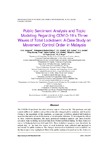Mostrar o rexistro simple do ítem
Public Sentiment Analysis and Topic Modeling Regarding COVID-19’s Three Waves of Total Lockdown: A Case Study on Movement Control Order in Malaysia
| dc.contributor.author | Alamoodi, A.H. | |
| dc.contributor.author | Baker, Mohammed Rashad | |
| dc.contributor.author | Albahri, O.S. | |
| dc.contributor.author | Zaidan, B.B. | |
| dc.contributor.author | Zaidan, A.A. | |
| dc.contributor.author | Wong, Wing-Kwong | |
| dc.contributor.author | Garfan, Salem | |
| dc.contributor.author | Albahri, A.S. | |
| dc.contributor.author | Alonso, Miguel A. | |
| dc.contributor.author | Jasim, Ali Najm | |
| dc.contributor.author | Baqer, M.J. | |
| dc.date.accessioned | 2022-10-05T14:47:48Z | |
| dc.date.available | 2022-10-05T14:47:48Z | |
| dc.date.issued | 2022-07-31 | |
| dc.identifier.citation | A.H. Alamoodi, Mohammed Rashad Baker, O.S. Albahri, B.B. Zaidan, A.A. Zaidan, Wing-Kwong Wong, Salem Garfan, A.S. Albahri, Miguel A. Alonso, Ali Najm Jasim, and M. J. Baqer. 2022. Public Sentiment Analysis and Topic Modeling Regarding COVID-19’s Three Waves of Total Lockdown: A Case Study on Movement Control Order in Malaysia. KSII Transactions on Internet and Information Systems, 16, 7, (2022), 2169-2190. DOI: 10.3837/tiis.2022.07.003. | es_ES |
| dc.identifier.issn | 1976-7277 | |
| dc.identifier.uri | http://hdl.handle.net/2183/31782 | |
| dc.description.abstract | [Abstract] The COVID-19 pandemic has affected many aspects of human life. The pandemic not only caused millions of fatalities and problems but also changed public sentiment and behavior. Owing to the magnitude of this pandemic, governments worldwide adopted full lockdown measures that attracted much discussion on social media platforms. To investigate the effects of these lockdown measures, this study performed sentiment analysis and latent Dirichlet allocation topic modeling on textual data from Twitter published during the three lockdown waves in Malaysia between 2020 and 2021. Three lockdown measures were identified, the related data for the first two weeks of each lockdown were collected and analysed to understand the public sentiment. The changes between these lockdowns were identified, and the latent topics were highlighted. Most of the public sentiment focused on the first lockdown as reflected in the large number of latent topics generated during this period. The overall sentiment for each lockdown was mostly positive, followed by neutral and then negative. Topic modelling results identified staying at home, quarantine and lockdown as the main aspects of discussion for the first lockdown, whilst importance of health measures and government efforts were the main aspects for the second and third lockdowns. Governments may utilise these findings to understand public sentiment and to formulate precautionary measures that can assure the safety of their citizens and tend to their most pressing problems. These results also highlight the importance of positive messaging during difficult times, establishing digital interventions and formulating new policies to improve the reaction of the public to emergency situations. | es_ES |
| dc.description.sponsorship | Taiwan. Ministry of Science and Technology; 108-2511-H-224-007-MY3 | es_ES |
| dc.language.iso | eng | es_ES |
| dc.publisher | KSII | es_ES |
| dc.relation.uri | http://doi.org/10.3837/tiis.2022.07.003 | es_ES |
| dc.rights | Copyright ⓒ 2022 KSII | es_ES |
| dc.subject | COVID-19 | es_ES |
| dc.subject | Lockdown | es_ES |
| dc.subject | Misinformation | es_ES |
| dc.subject | Sentiment analysis | es_ES |
| dc.subject | Topic modeling | es_ES |
| dc.title | Public Sentiment Analysis and Topic Modeling Regarding COVID-19’s Three Waves of Total Lockdown: A Case Study on Movement Control Order in Malaysia | es_ES |
| dc.type | info:eu-repo/semantics/article | es_ES |
| dc.rights.access | info:eu-repo/semantics/openAccess | es_ES |
| UDC.journalTitle | KSII Transactions on Internet and Information Systems | es_ES |
| UDC.volume | 16 | es_ES |
| UDC.issue | 7 | es_ES |
| UDC.startPage | 2169 | es_ES |
| UDC.endPage | 2190 | es_ES |
Ficheiros no ítem
Este ítem aparece na(s) seguinte(s) colección(s)
-
GI-LYS - Artigos [51]






